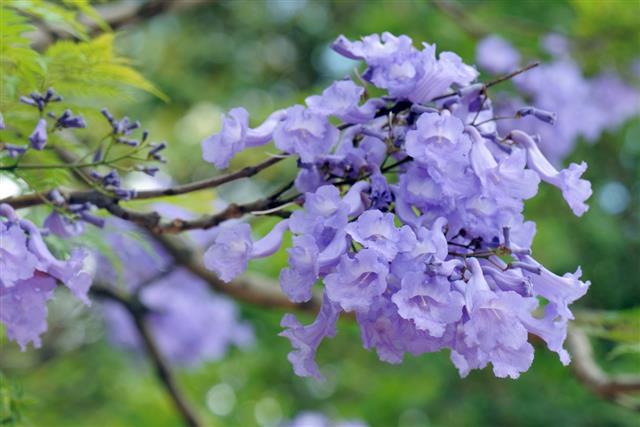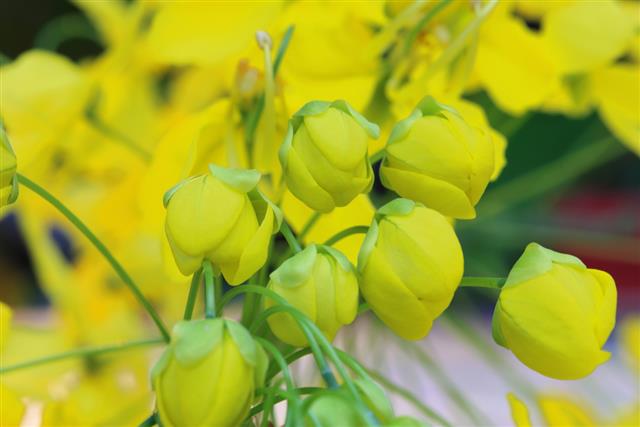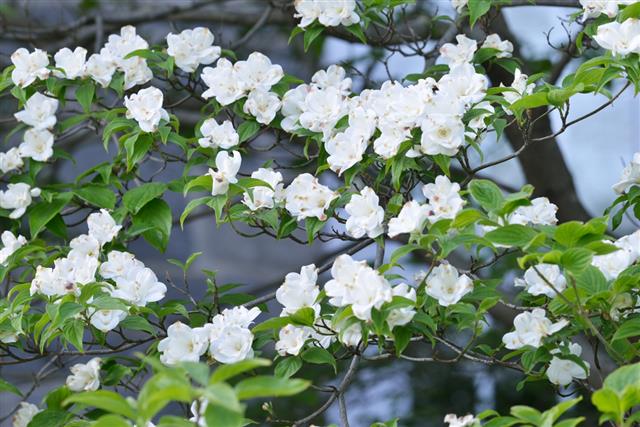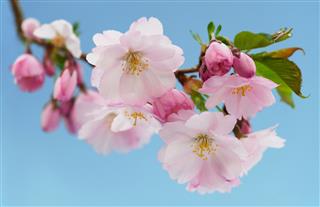
There are over a hundred types of flowering trees that one can plant in their garden to beautify the landscape. This article will tell you all about some of them.
While flowering plants and shrubs can add beauty, form, and shape to your landscape, a flowering tree; lone or grouped, will highlight even the dullest corners as well as lend a transitory color to the garden each season. Growing a flowering tree requires attention to few details; height, ground, and crown cover, seasonal leaves and flower shedding, care and maintenance, diseases, etc. It is best to get information about the tree you want to grow, from the nursery you plan to pick them from. But for deciding on which one you want, go through this article, which enlists the different types of flowering trees.
Plum Tree
The beautiful flowering plum tree is a medium-sized tree that will reach 20 to 25 feet, with a crown spread of 15 feet. It is slightly partial to a well-drained, slightly acidic soil and moderate watering. Not only does it sprout ornamental flowers, but its leaves also add color to the landscape. The flowers bloom in clusters of white, purple, and pink colors in the springtime, followed by the change in the foliage color from the leaves’ shiny green to a deep, bright burgundy. The fruits appear late in the summer and the sweet plums turn pink upon reaching maturity.
Tulip Poplar
The Tulip Poplar gets its name from its tulip looking yellow flowers. The poplar is very fast growing tree, that can grow 15 to 20 feet in height in just six years. Its water requirements are moderate, but it needs lots of space to grow. It does well in most soils, but does not prefer salt and alkali soils. Springtime sees this giant tree come to life with masses of tulip-like flowers. The flowers last for a long time on the tree and are greenish-yellow with an orange band. The deciduous leaves turn golden yellow from green in fall, before shedding foliage at the end of the growing season.
Flowering Almond
It is more of a multi-stemmed, deciduous shrub, than a tree. However, it is so popular among gardeners, that they prefer to grow it as a tree. It does not attain height more than 4-5 feet and a spread of more than 3-4 feet. Native to China, it prefers moist well-drained soils and full sun. Mid spring it blooms with white or pink flowers, single or double, depending on the cultivator, with very small red cherry like fruits. The foliage color does not change in this deciduous flowering almond.
Flowering Dogwood
A showy tall deciduous tree that is well-known and widely planted throughout America. There are several varieties of dogwood one can choose from, each bursting with life and color every spring. Some of the most popular varieties include Cherokee Chief, Flowering Dogwood, Carnelian Cherry, Japanese Dogwood, Pagoda Dogwood, Pacific Dogwood, etc.
A dogwood offers the landscape a visual treat throughout the year. This 33 feet and more tall tree blooms with red, white, or pink-colored flowers that last for two weeks. Fall brings a change in its foliage color; from green to shades of red and purple. Shiny red fruits add to the autumn treat, and finally in winters, its bare barks, with next season’s buds complete the cycle of enticing the onlooker. The tree prefers full sun and will grow in most soils.
Flowering Cherry
If shade of pink is what you seek, don’t think beyond this tree. It grows to be 30-40 feet in height with a spread of nearly 15 to 20 feet. It grows very fast, and will offer a beautiful bloom besides the sweet luscious cherries. Its varieties include Weeping cherry, Kwanzan cherry, Japanese cherry, Yoshino cherry, Okame cherry, etc. Adaptable to most climatic and soil conditions, this tree blooms in gorgeous white and shade of pink blossoms every spring, and its foliage changes color in the fall, with green leaves turning to shades of red, yellow and/or orange depending upon the variety.
Flowering Lilac Tree
It is a hardy, deciduous, small tree, that grows no more than 25-30 feet in height. It is easy to grow, prefers full sun, and will tolerate all kinds of soils while being slightly partial for a chalky clay type. Being a hardy tree, it rarely gets infected with pest and diseases. It gets covered by large plumes of small lilac, white, and pink color flowers in the beginning of summer and last up to spring. The Japanese lilac tree is emerging as quite a favorite among many landscapers. The foliage is bright green that does not change in fall.
Flowering Crabapple Tree
Everyone who has visited New York City parks in spring, from mid-April into May, come back with soulful memories of the sights and scents of flowering crabapples. The mature height of these trees is around 20 feet, and can be easily trained to grow as hedges or shrubs. Easy to grow and resistant to pest and diseases, except the common fungal infection Apple scab, this tree will give very little trouble. The flowers bloom in spring in clusters of fragrant white, pink, or dark rose colors. When you get this tree from the nurseries, ask for multi stemmed branching form rather than the single stemmed to get a stunning effect in the spring season.
Magnolia Tree
A prominent feature of the Southern landscape, Magnolia trees come in nearly 80 different species, that are native to the eastern United States and southeastern Asia. These evergreen or deciduous (depending upon the variety) are mostly pest and insect resistant, (except for the snails and slugs) that bear large, fragrant flowers, in colors that range from white to shades of pink, and new hybrids of deep purple-red and yellow color. They prefer well drained, slightly acid soil which is rich in organic matter. Depending upon the variety, Magnolias grow to 25 to 60 feet in height and bear flowers either in early or late spring.
Catalpa Tree
Native to Asia, the Catalpa is known for its height of nearly 40 to 60 feet and white showy orchid-like flowers with red, yellow, and purple streaks on the inner sides. Catalpa’s crown is naturally rounded and upright, with distinctive heart-shaped, large size of up to 12 inches long green leaves. The tree blooms with flowers from May to June. It only starts to bear flower and fruit after it has reached the age of seven years.
Gulmohar
The Gulmohar, widely grown all over the world and also known as ‘Flame of the Forest’, because of its distinctively bright red orange colored flowers, that burst upon the tree every spring and summer time. Native to Madagascar, this flamboyant tree was introduced in America by explorers. This ornamental shade tree can grow up to 20-30 feet in height, with long and widespreading branches that make it an excellent shade tree. This tree will grow in almost any kind of a soil, and has found to be very adaptable to xeriscape gardening form. For it to flower, it requires full sun. An interesting feature about this tree is that it shows the first signs of excess pollution, in the area it grows in, by bearing reduced number or no flowers at all.
Flowering Pear Tree
A white flowering tree, pear trees are a sight to behold, with their snowy white full sheet coverage on the tree. Pear trees are small, between 20 to 40 feet high, that grow in a natural oval shape with its rough bark and an upright growth. Pear leaves are generally longer and more pendulous. Mid April, the green pear tree changes color so dramatically that it almost looks like a snow clad tree. The flowers bloom in large clusters, lasting generally until about the middle of the following month. They are very easy to grow and maintain, and tolerant of drought. Among many varieties like Silver Frost pear, Aristocrat pear, Bradford pear, etc, it is the Cleveland Select pear tree that is a fruitless hybrid.
Hawthorne Tree
Hawthorne is a deciduous member of the rose family and native to the Mediterranean region including north Africa, Europe, and central Asia. This is one tree that has been hybridized many times to create new species, adaptable to many growing conditions. This is one tree that can live for long; nearly 400 years and has the capacity to flower twice in a year, depending upon climatic conditions. The white snowy, red, or pink flowers grow in flat clusters, among the small bright green colored leaves.
In the center of each flower, is the bunch of stamens, whose delicate pink anthers discharge their pollen as they mature. In some varieties, like the Washington hawthorn, the leaves turn orange-red in the fall, then fade away to reveal an abundant crop of bright, glossy red berries.
Golden Rain Tree
Native to eastern Asia, the Golden Rain is a fast-growing, deciduous tree, reaching about 30 feet in height with a crown spread almost equal to its height, upon maturity. It is an extremely hardy tree, adaptable to most soil conditions, although it prefers loose, well drained soil. It requires full sun to flower well and frequent watering when young. Established trees can even tolerate dry, drought-like conditions. It flowers mid summer, and the flowers are green-yellow to bright yellow in color that grow in foot-long large panicle. As the flowers do not open all at once, the flowering is prolonged, which segue into ornamental red-purple seed pods.
Redbud Trees
A Redbud in full bloom can be quite a spectacular view to behold. Among small flowering tree, Redbuds are quite popular. They rarely grow over 30 feet tall and spread no more than 30 feet. Their blossoms come true in full sun in early spring, and are of purple pink color. They are easy to grow and maintain, the only thing to bear in mind is that they dislike swampy or very wet soils. This deciduous tree has large heart-shaped leaves that turn a bright sunny yellow in fall.
Pink Poui Tree
An evergreen deciduous tree, Pink Poui, also known as Tabebuia Rosea is upright tree that grows to great heights; 70 to 80 feet with a widespread of approximately 30 to 50 feet. Its branches are long, making it an excellent shade tree. This tree is a favorite among landscapers for parks and large gardens. It flowers mostly in summers. The tree sheds all foliage before double-petaled pink, white, yellow, or purple colored flowers grow in clusters. This tree and all its parts have been in use for many medicinal purposes too.
Jacaranda Tree
Native to South Africa and Brazil, Jacaranda is an extremely beautiful ornamental tree that bears shades of purple or blue lavender flowers. It can grow up to 98 feet in good climatic conditions. In most cases, it will bear purple flowers, but there are a few rare species that bear white-colored ones. The flowers bloom during summers in large panicles, where each flower is five-lobed. The tree prefers hot and sunny environment, and tends to get damaged with frost.
Dwarf Red Buckeye
One of the varieties of dwarf flowering trees is the Dwarf Red Buckeye that does not grow more than 20 feet and a spread of 15 feet. It prefers full sun to flower well. The leaves are large and lush with a drooping appearance and bears deep crimson flowers early summer. This tree starts to flower within three years of planting it in sapling stage. It is known as an early riser because it is the first tree to sprout new leaves, signaling the arrival of spring. It will grow well in well-drained soil and moderate climate.
Bottlebrush
Bottlebrush is among the hardiest of all Australian natives. It attains the height of only 15 feet, but there are certain varieties that can grow up to 30 feet as well. They live long and require very little care and maintenance. They require full sun, and are drought-tolerant, but need occasional watering especially when they are young. They come in three varieties that determine their color; red, purple, pink, white, green, or yellow. The leaves have an interesting elongated, narrow, and pointed shape, from which colorful auxiliary spikes of numerous, long-stamened flowers grow.
Yellowwood
Yellowwood is a rare medium-sized tree that is now found only in a handful of counties in North Carolina. It is a slow grower with low branches that grows between 30 to 50 feet tall and spreads even wider. Winner of the prestigious 1994 Pennsylvania Horticultural Society Gold Award, this beauty blossoms in late spring with foot long flower clusters, that droop from the branches. The flowers can either be white or light pink. Its fall color is sunny yellow. It can be grown in both high pH and acidic soils.
The list could easily go on and on forever, as we have been bestowed with an abundance of natural beauty. However, I have mentioned the ones that are easily available in most plant nurseries, so one can easily decide and pick. If I have missed out on some important ones, do let me know. Meanwhile, enjoy the beauty of these flowering trees.


















